Understanding Cervicalgia and the Importance of Targeted Intervention
Cervicalgia, a clinical term for neck pain, is a condition that affects millions of adults worldwide. Often stemming from muscle strain, poor posture, or degenerative disc disease, cervicalgia can significantly disrupt quality of life by limiting mobility, triggering headaches, and compromising sleep. In more severe or chronic cases, it may also radiate pain into the shoulders and upper back, making daily tasks like driving, typing, or even sleeping difficult. The cervical spine, consisting of seven vertebrae at the top of the spinal column, plays a pivotal role in supporting the head and facilitating movement. As such, any disruption to its function demands careful and consistent attention.
You may also like : Best Stretches for Sore Legs and Tight Thigh Muscles: How to Relieve Upper Leg Pain Safely and Naturally
While cervicalgia may resolve on its own with rest and ergonomic adjustments, long-term relief often depends on targeted rehabilitation. This includes cervicalgia exercises, physical therapy for cervical pain, and a structured approach to neck rehabilitation. Understanding the anatomy of the cervical spine, the biomechanics of neck movement, and the pathophysiology of chronic strain or inflammation allows physical therapists to design programs that provide both immediate symptom relief and sustainable long-term support. Importantly, these programs can be tailored to address the root causes of cervicalgia, whether they stem from poor posture, muscular imbalances, or degenerative changes.
The Role of Physical Therapy in Managing Cervicalgia
Physical therapy for neck pain has emerged as one of the most effective non-invasive interventions for cervicalgia. Trained physical therapists conduct comprehensive assessments to identify not only the source of pain but also underlying dysfunctions in mobility, strength, and posture. By customizing a therapeutic regimen, they address both symptomatic relief and functional improvement. This may include manual therapy, cervical spine exercises, soft tissue mobilization, and neuromuscular reeducation. Such multifaceted care ensures that treatment is not merely palliative but corrective and preventative.
Patients undergoing physical therapy for cervical pain often experience gradual but sustained improvements in range of motion, muscular endurance, and postural alignment. Techniques such as manual traction, myofascial release, and targeted mobilization help alleviate compressive forces on the cervical vertebrae, while active therapy builds resilience against future strain. Moreover, incorporating pt for neck pain into a broader lifestyle shift—like ergonomic adjustments at work or reducing screen time—can produce synergistic benefits. The therapeutic alliance between patient and provider, combined with education and self-management strategies, plays a critical role in promoting long-term recovery.
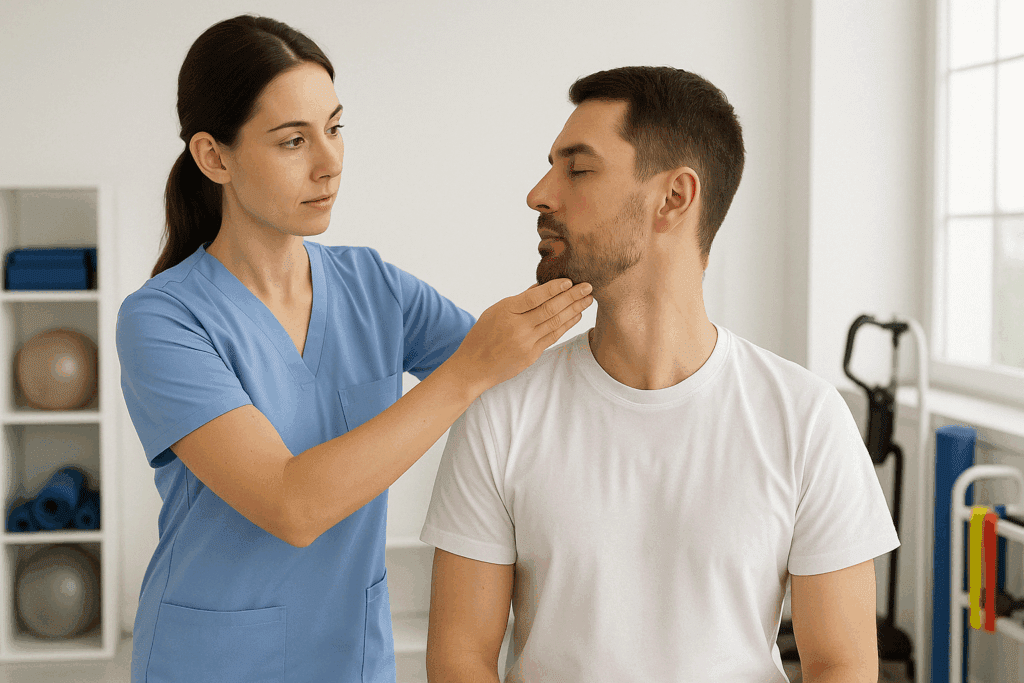
The Ergonomic Connection: How Workstations Influence Cervical Pain
One of the most overlooked yet impactful aspects of cervicalgia management is ergonomics. Many patients struggling with neck strain spend hours hunched over desks, laptops, or mobile devices—often in positions that place chronic stress on the cervical vertebrae. Addressing this occupational hazard is a key element in preventing recurrence, even in individuals who regularly perform cervical strengthening exercises or follow their pt for neck pain plan with dedication.
Adjusting monitor height, investing in an ergonomic chair, and using a standing desk can dramatically reduce forward head posture and relieve the muscular tension that contributes to chronic neck strain. The goal is to maintain a neutral spine throughout the workday, with the ears aligned over the shoulders and the screen at eye level. Armrests should allow the elbows to rest at a 90-degree angle, while the lower back is supported to prevent compensatory forward tilting of the head.
Employers increasingly recognize the importance of ergonomic assessments, and many now offer on-site consultations or stipends for home-office upgrades. Integrating neck stability exercises into short hourly breaks can further combat the effects of prolonged sitting. Something as simple as a one-minute chin tuck paired with shoulder blade squeezes every hour can interrupt harmful postures and reinforce healthy alignment. Ergonomics and physical therapy for cervical pain work synergistically to reduce daily strain and promote healing.
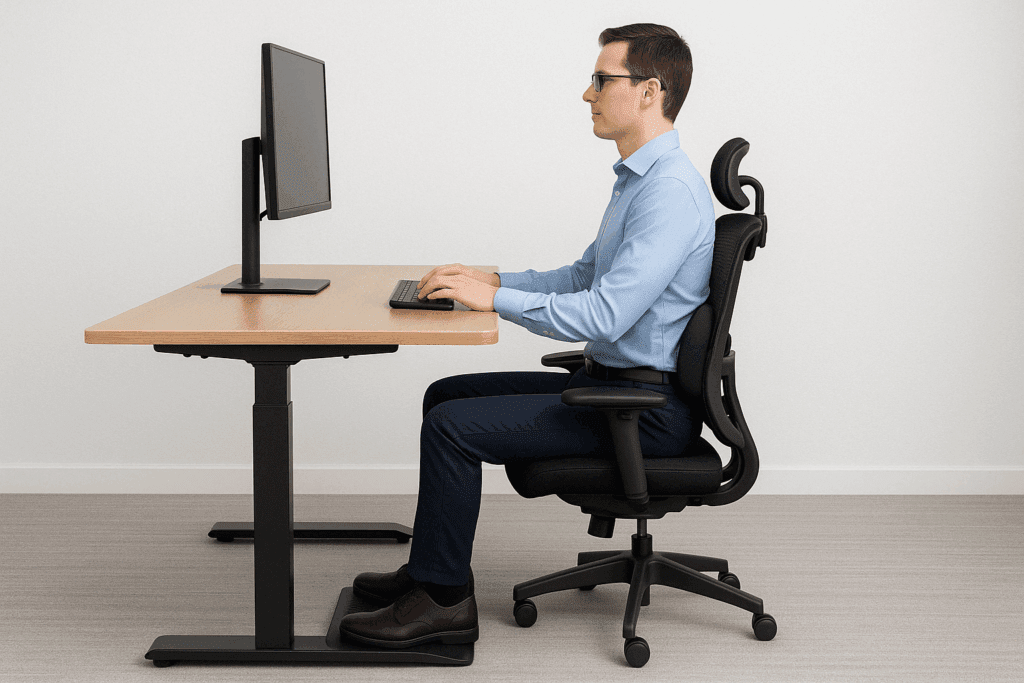
Stress and Cervicalgia: The Psychosomatic Link
Chronic stress plays a significant role in musculoskeletal pain, particularly in the cervical region. Emotional tension often manifests physically through muscle bracing, especially in the shoulders, upper back, and neck. Over time, this low-level tension can contribute to trigger points, poor posture, and persistent discomfort. While physical therapy techniques for neck pain often target these symptoms biomechanically, addressing their psychological root is equally important for lasting relief.
Mind-body practices such as meditation, progressive muscle relaxation, and guided imagery can complement cervical spine exercises and reduce overall pain intensity. Deep breathing during neck stretches in physical therapy can calm the nervous system and support tissue recovery. Cognitive-behavioral therapy (CBT) has also shown promise in treating chronic neck pain by helping patients reframe maladaptive thought patterns that contribute to tension or pain catastrophizing.
Yoga, particularly gentle or restorative forms, blends physical movement with mindfulness and can serve as a bridge between physiotherapy exercises for neck pain and relaxation. Poses that focus on thoracic mobility, such as cat-cow or supported fish pose, release tension in the surrounding areas of the cervical spine. When these practices are integrated into a cervical spine rehab plan, patients often report better sleep, lower anxiety, and greater resilience to flare-ups.
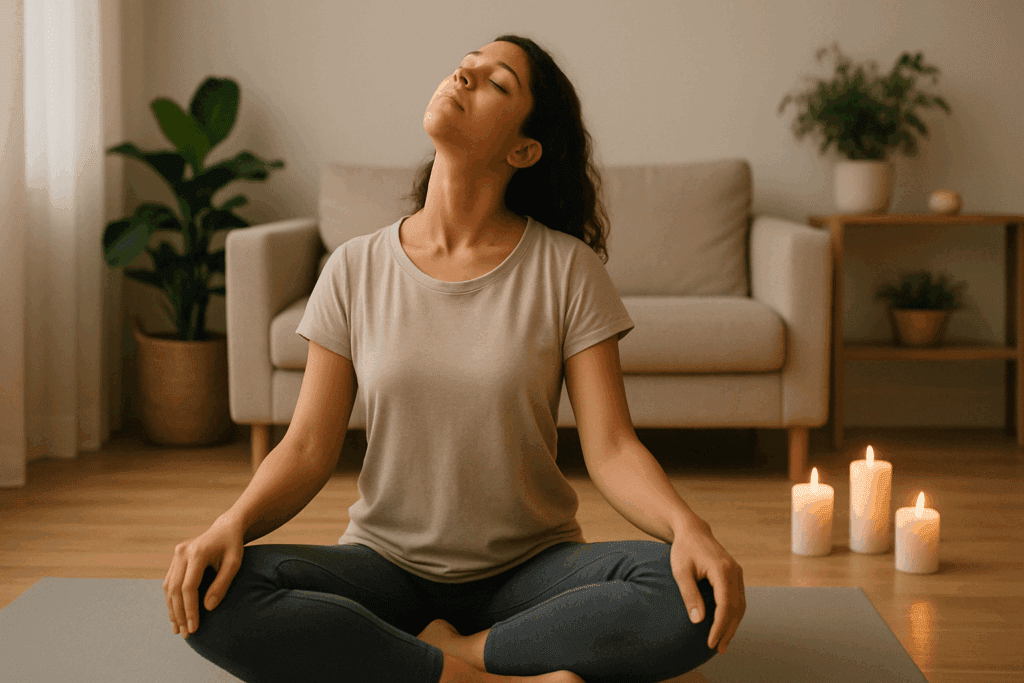
Sleep Positioning and Recovery for the Cervical Spine
Restorative sleep is a cornerstone of musculoskeletal healing, yet many individuals with cervicalgia unknowingly sabotage recovery through poor sleep positioning. The position of the head and neck during sleep can either support the cervical vertebrae or exacerbate compression and strain. For patients undergoing physical therapy for neck strain, optimizing sleep posture can reduce morning stiffness, improve mobility, and enhance overall outcomes.
Side sleeping with a supportive pillow that maintains neutral alignment is generally recommended. The pillow should fill the space between the head and shoulder, preventing excessive tilting or bending. Back sleeping can also be beneficial if the neck is supported with a contoured pillow that follows the natural cervical curve. Stomach sleeping, by contrast, forces the head into extreme rotation and should be avoided.
Some physical therapists recommend specialty cervical pillows or adjustable memory foam options to accommodate individual preferences. Nighttime applications of heat or a guided relaxation routine before bed can reduce muscle tension and promote parasympathetic activity. These strategies, when integrated with cervical neck exercises and daytime posture awareness, contribute to a full-spectrum recovery approach.
Foundational Cervicalgia Exercises for Pain Relief and Mobility
For individuals beginning a neck rehabilitation program, foundational cervicalgia exercises are essential in establishing mobility and reducing acute discomfort. These initial movements emphasize gentle range-of-motion activities that prioritize safety, control, and pain-free execution. Neck stretches in physical therapy, such as chin tucks, side bends, and rotation exercises, work to reestablish movement in the cervical vertebrae without exacerbating inflammation. These motions help mobilize stiff joints, decrease muscular tension, and promote circulation to inflamed tissues.
Cervical mobility exercises are often performed in a seated or supine position to minimize gravitational strain. For instance, cervical flexion and extension can be practiced with the head supported by a towel roll to encourage correct movement patterns. Controlled repetitions of looking side to side or tilting the ear toward the shoulder serve as excellent starting points for mobility restoration. Over time, these exercises can be progressed by increasing repetition, duration, or complexity—such as integrating them into functional movements like turning the head while walking or sitting upright at a desk. The objective at this stage is not maximal effort but optimal alignment and coordination.
In addition to physical movement, the breath plays a crucial role in mobility restoration. Deep diaphragmatic breathing while performing cervicalgia physical therapy exercises supports parasympathetic nervous system activation, which promotes muscle relaxation and pain modulation. By reinforcing calm, coordinated movement with breath awareness, patients can shift from guarded, protective posturing to fluid, confident motion—a key milestone in cervical spine rehab.
Advanced Cervical Strengthening Exercises for Long-Term Neck Support
Once acute pain subsides and mobility improves, physical therapy for neck strain transitions into strengthening and stabilization. Cervical strengthening exercises help build endurance and muscular control in the deep cervical flexors, upper trapezius, levator scapulae, and surrounding postural muscles. These exercises are vital for maintaining proper head posture, preventing future episodes of neck strain, and supporting functional movements like lifting, driving, or prolonged sitting.
A cornerstone of cervical strengthening is the isometric chin tuck. This movement targets the longus colli and longus capitis—deep neck flexors responsible for maintaining cervical lordosis. When performed with proper alignment, chin tucks can retrain the neck to assume a more neutral posture. Wall angels, resisted flexion with bands, and prone head lifts further develop neuromuscular control and endurance. These movements require precision and should be introduced progressively under the supervision of a physical therapist to avoid compensation from superficial muscles.
Equally important are scapular stabilizer exercises. The health of the cervical spine is intimately connected to the function of the shoulder girdle, especially the scapulae. Strengthening the rhomboids, lower trapezius, and serratus anterior helps unload the cervical spine by promoting thoracic extension and proper shoulder positioning. For instance, prone Y’s and T’s, scapular retractions, and wall slides can be integrated into a cervical spine rehab program to enhance global postural support.
Consistency and proper form are critical when performing cervical neck exercises. Rushing through reps or relying on accessory muscles may compromise results or exacerbate discomfort. Instead, exercises should be executed with intention, control, and progressive loading as strength improves. This phase of neck pt exercises is where resilience is built, ensuring that patients not only recover from cervicalgia but also prevent its recurrence.
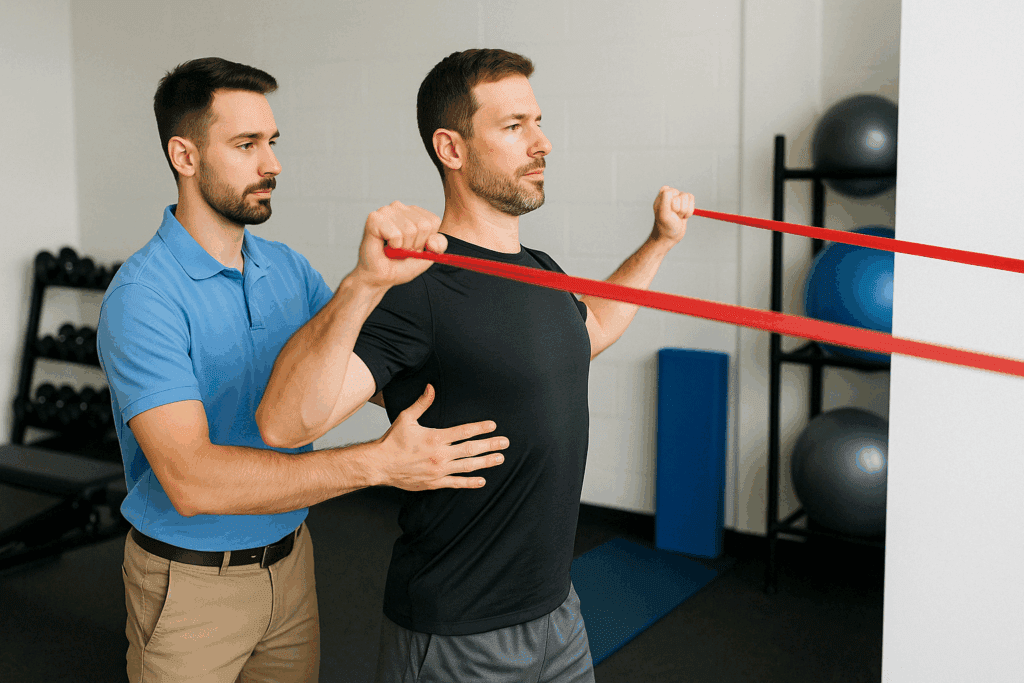
The Science Behind Physical Therapy Techniques for Neck Pain
Modern physical therapy techniques for neck pain are rooted in evidence-based practices that draw from biomechanics, neuroscience, and musculoskeletal medicine. Manual therapy, a common technique used in physical therapy neck treatments, involves hands-on manipulation of soft tissue and joints to relieve tension, improve mobility, and restore function. Research suggests that manual therapy, when combined with exercise, is more effective than exercise alone for certain patients with cervicalgia.
Neurodynamic mobilization is another sophisticated approach, often used when neck pain radiates into the arm—a sign of nerve root irritation. This technique aims to improve the mobility and health of the nervous system by gently gliding nerves through their surrounding tissues. When integrated with cervical spine exercises physical therapy, it can reduce pain and restore function in patients with radiculopathy or other neuropathic symptoms.
Motor control training is increasingly emphasized in contemporary pt for neck programs. This method focuses on retraining how the brain controls cervical movement, especially after chronic pain disrupts normal muscle activation patterns. Through targeted biofeedback, mirror therapy, or movement retraining, patients relearn how to move efficiently without fear or pain. This neuromuscular reeducation is essential for restoring confidence and preventing re-injury.
Furthermore, modalities such as ultrasound, electrical stimulation, and heat or ice may be used to enhance comfort and promote tissue healing in the early stages of therapy. While not a substitute for active care, these techniques can facilitate progress when used judiciously within a comprehensive cervical physical therapy program. The integration of manual and active treatments reflects the dynamic and multifactorial nature of cervicalgia rehabilitation.
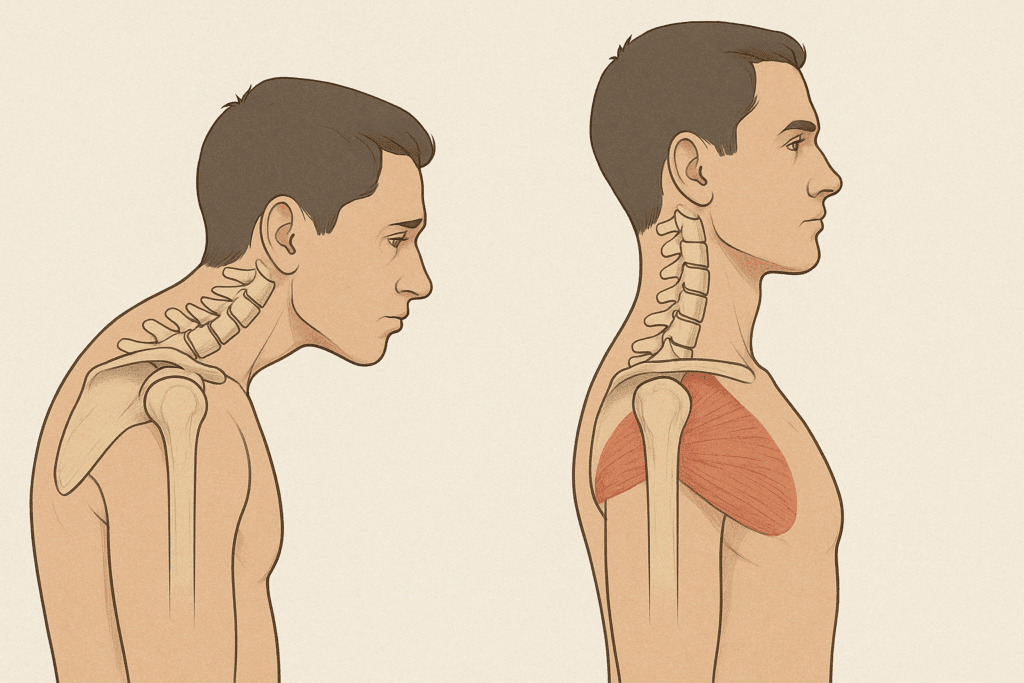
Cervical Spine Exercises and Their Role in Postural Realignment
Postural dysfunction is one of the most common contributors to cervicalgia, particularly in our digitally connected world. Extended periods of forward head posture—whether at a computer, smartphone, or in the car—place excessive load on the cervical vertebrae and supporting musculature. Over time, this leads to strain, degeneration, and compensatory movement patterns that perpetuate pain. Physical therapy exercises for cervical neck pain often emphasize postural correction as a central therapeutic goal.
Cervical spine exercises such as scapular setting, thoracic extension, and deep neck flexor activation retrain the body to adopt a more upright, aligned posture. These movements often begin in supine or seated positions but gradually progress to functional tasks like sitting at a desk or lifting groceries. Integrating posture training into real-world contexts is essential for creating lasting behavioral change.
One of the most effective strategies for postural improvement involves proprioceptive training. This includes the use of mirrors, tactile cues, or laser pointers affixed to a headband to give feedback about head position. These simple yet effective tools empower patients to recognize and correct faulty alignment during daily tasks. As cervical vertebrae exercises restore structural integrity and control, postural habits begin to shift—reducing the mechanical load on the neck and mitigating symptoms.
A comprehensive program of physical therapy for neck pain that includes posture-focused cervicalgia exercises also helps address associated symptoms like tension headaches, upper trapezius tightness, and thoracic kyphosis. By restoring optimal biomechanics through repeated practice, patients develop not only stronger necks but also healthier, more functional movement patterns across the entire upper body.
Printable Neck Stretches and Home-Based Physiotherapy Programs
While in-clinic physical therapy for neck strain is ideal for many patients, home-based programs are essential for maintaining progress between sessions. Printable neck stretches and guided cervical spine rehab routines allow individuals to practice their exercises consistently and correctly, even outside of the clinic setting. These resources should include detailed instructions, proper form cues, and suggested frequency to ensure safe execution.
Common home-based cervicalgia physical therapy exercises include upper trapezius stretches, levator scapulae releases, chin tucks, and cervical rotations. These exercises help relieve tension, promote blood flow, and maintain mobility. Using tools like a foam roller, yoga strap, or resistance band can add variety and intensity to the routine, preventing stagnation and enhancing results.
Tele-rehabilitation has further expanded access to cervical neck exercises. Through virtual check-ins, video demonstrations, and real-time feedback, physical therapists can monitor progress and modify routines as needed. This hybrid model of care empowers patients to take an active role in their recovery while ensuring they receive professional oversight.
The effectiveness of physiotherapy exercises for neck pain hinges on consistency, form, and adherence. Patients are encouraged to set reminders, track progress, and integrate exercises into daily routines—such as performing stretches during work breaks or doing a mobility drill before bedtime. The more seamlessly cervical spine exercises are woven into one’s lifestyle, the more sustainable the results.
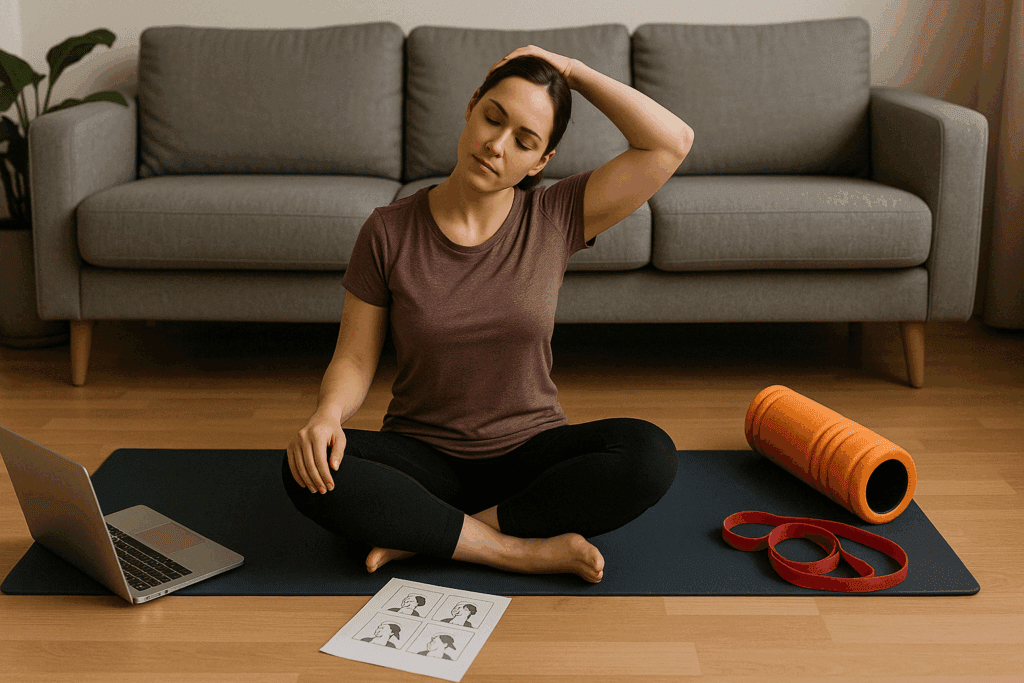
Creating a Personalized Plan for Cervical Spine Rehab and Recovery
No two cases of cervicalgia are identical, and effective treatment requires an individualized plan that reflects the patient’s history, goals, and physical capabilities. Whether dealing with acute trauma, repetitive strain, or chronic degeneration, a successful plan combines cervical mobility exercises, neck stability exercises, and functional training that mimic the demands of daily life.
The first step in creating a cervical spine rehab plan involves a thorough evaluation. This may include range-of-motion testing, muscle strength assessments, postural analysis, and a review of ergonomic habits. From there, a phased approach can be developed, starting with pain reduction and mobility, progressing to strength and stabilization, and ultimately transitioning to functional integration and maintenance.
Key elements of a successful plan include clear goals, measurable milestones, and built-in flexibility to adapt to the patient’s progress. Communication between the patient and therapist is vital for modifying intensity, addressing setbacks, and celebrating improvements. As patients become more confident in their neck rehabilitation exercises, they often gain a sense of empowerment that transcends physical healing.
A well-rounded program also includes education on preventing recurrence. This may involve ergonomic recommendations for computer use, guidance on lifting technique, stress management strategies, and sleep posture advice. By addressing the biopsychosocial dimensions of cervicalgia, physical therapy becomes not just a treatment—but a gateway to sustainable health and resilience.
Frequently Asked Questions: Cervicalgia Exercises, Physical Therapy, and Neck Rehabilitation
1. Can cervical strengthening exercises help prevent future neck injuries?
Absolutely. Cervical strengthening exercises not only enhance the stability of the cervical vertebrae but also reduce the risk of injury from everyday activities such as lifting, driving, or working at a computer. These exercises build endurance in deep stabilizing muscles that are often underused, which can improve balance and proprioception. Athletes and individuals with physically demanding jobs may especially benefit from targeted cervical neck exercises that mirror real-world movements. When cervical spine exercises are incorporated consistently into a fitness regimen, they act as a proactive buffer against sudden strains or cumulative wear-and-tear on the cervical spine.
2. What’s the difference between cervicalgia exercises and general neck stretches?
Cervicalgia exercises are tailored specifically to address the biomechanical and muscular imbalances that contribute to cervical pain, whereas general neck stretches may provide temporary relief without correcting underlying dysfunction. For example, cervicalgia physical therapy exercises often include a progression from passive range-of-motion drills to active stabilization techniques. While both approaches may incorporate neck stretches physical therapy practitioners recommend, cervicalgia exercises tend to be more structured and rehabilitative. They often include neuromuscular control components that retrain the body to move efficiently and pain-free. In contrast, generic stretches lack this specificity and may not produce lasting results for those dealing with chronic cervical issues.
3. Are printable neck stretches effective when used without professional supervision?
Printable neck stretches can be helpful as part of a home exercise program, especially when developed by a licensed physical therapist. However, they are most effective when combined with individualized instruction, particularly in the early stages of cervical spine rehab. Without proper form, patients may unintentionally exacerbate cervical pain or neglect critical stabilizing muscles. That said, well-designed printable neck stretches can reinforce the benefits of in-clinic physical therapy exercises for neck pain, serving as daily maintenance to preserve gains in flexibility and posture. Patients should always consult their provider before relying solely on unsupervised stretches.
4. How do cervical mobility exercises differ from cervical stability exercises?
Cervical mobility exercises aim to restore natural range of motion in the cervical spine by addressing joint stiffness, muscle tightness, and fascial restrictions. These exercises are essential in the early phases of recovery from cervicalgia, particularly after injury or long periods of immobility. In contrast, cervical stability exercises focus on controlling that motion, often by activating the deep cervical flexors and postural muscles. While mobility improves access to movement, stability ensures that this movement is safe and functional. An optimal neck rehabilitation program incorporates both—beginning with cervical mobility exercises and progressing toward neck stability exercises for long-term protection.
5. What role do physical therapy techniques for neck pain play in managing headaches?
Many tension-type headaches are linked to dysfunction in the upper cervical vertebrae and surrounding musculature. Physical therapy techniques for neck pain—such as suboccipital release, cervical traction, and posture correction—can significantly reduce headache frequency and intensity. These techniques often complement cervicalgia exercises by targeting referred pain patterns originating from the neck. Additionally, pt for neck pain frequently includes patient education on ergonomics and sleep positioning, which are key to managing cervicogenic headaches. The synergistic effect of hands-on therapy and neck pt exercises helps alleviate both local and referred pain.
6. Are there physiotherapy exercises for neck pain that also help shoulder tension?
Yes, many physiotherapy exercises for neck pain are designed to address the interconnected function of the neck and shoulder girdle. For instance, scapular retraction drills and thoracic extension work help redistribute strain away from the cervical spine. Pt exercises for neck and shoulder pain often include strengthening the lower trapezius and serratus anterior to improve scapular mechanics. This approach alleviates upper trapezius dominance, which frequently contributes to cervicalgia. By addressing both regions together, cervical physical therapy exercises promote comprehensive upper body balance and relieve cumulative tension.
7. Can physical therapy for cervical pain reduce reliance on medication?
Over time, consistent physical therapy for cervical pain can reduce the need for pain-relieving medications by treating the root causes of discomfort. Rather than masking symptoms, cervicalgia physical therapy exercises retrain neuromuscular pathways, improve tissue health, and correct postural dysfunction. As mobility improves and inflammation decreases, many patients report a reduced frequency of flare-ups and a diminished need for NSAIDs or muscle relaxants. While acute flare-ups may still require pharmaceutical intervention, long-term engagement in physical therapy neck programs often results in greater self-sufficiency. This empowers individuals to manage their condition with fewer side effects and better overall health outcomes.
8. What are some advanced cervical spine exercises physical therapy may include?
Advanced cervical spine exercises in physical therapy programs often involve dynamic stabilization, resistance-based training, and integration into functional tasks. For example, resistance band movements that simulate turning the head while resisting external force help build muscular control. Functional drills might include controlled head movements during balance exercises or while lifting light weights. These advanced cervical strengthening exercises require precise neuromuscular coordination and are typically introduced only after mastering foundational movements. As part of a comprehensive cervical spine rehab strategy, they help patients transition from recovery to performance.
9. How important is breathing in performing neck exercises for neck pain physical therapy?
Breathing plays a surprisingly important role in executing neck exercises for neck pain physical therapy correctly. Many patients with cervicalgia unknowingly adopt shallow, chest-based breathing patterns that overuse the accessory neck muscles, increasing tension. Learning to engage the diaphragm during cervicalgia exercises can reduce strain on the scalenes, sternocleidomastoid, and upper traps. Physical therapists often cue deep belly breathing during cervical spine exercises to foster relaxation and improve core stability. When breath and movement are integrated mindfully, the benefits of pt for neck become even more pronounced, both physically and neurologically.
10. What lifestyle habits should accompany physical therapy exercises for cervical neck pain?
To maximize the impact of physical therapy exercises for cervical neck pain, patients should adopt lifestyle habits that support spinal health and reduce strain. This includes optimizing workstation ergonomics, taking regular breaks from screen use, and practicing mindful posture throughout the day. Nutritional support for tissue healing—such as adequate hydration, anti-inflammatory foods, and magnesium-rich diets—can enhance recovery. Sleep hygiene also plays a role, with cervical pillows and supportive positioning making a difference. When cervical vertebrae exercises are combined with healthy daily habits, long-term relief becomes more achievable and sustainable.
Conclusion: Embracing Cervical Physical Therapy for Long-Term Neck Health
Living with cervicalgia doesn’t have to mean a life of discomfort, limitation, or reliance on medication. Through expert-guided physical therapy for cervical pain, targeted cervicalgia exercises, and consistent engagement in home-based routines, individuals can take meaningful steps toward relief and recovery. Whether managing a recent flare-up or addressing a long-standing issue, the combination of mobility work, cervical strengthening, and postural reeducation offers a powerful, holistic approach.
Incorporating cervical spine exercises physical therapy into daily life not only reduces the intensity of neck pain but also addresses its root causes. With attention to posture, muscle balance, and movement patterns, these therapeutic interventions create a foundation for long-term spinal health. By working closely with a physical therapist, setting realistic goals, and maintaining a regular practice of neck pt exercises, individuals gain both the tools and confidence to manage their condition proactively.
Ultimately, embracing cervicalgia physical therapy exercises as part of a comprehensive health plan enables people to reclaim comfort, function, and vitality. The journey may require patience and persistence, but the results—a pain-free neck, improved posture, and a stronger sense of well-being—are well worth the effort.


